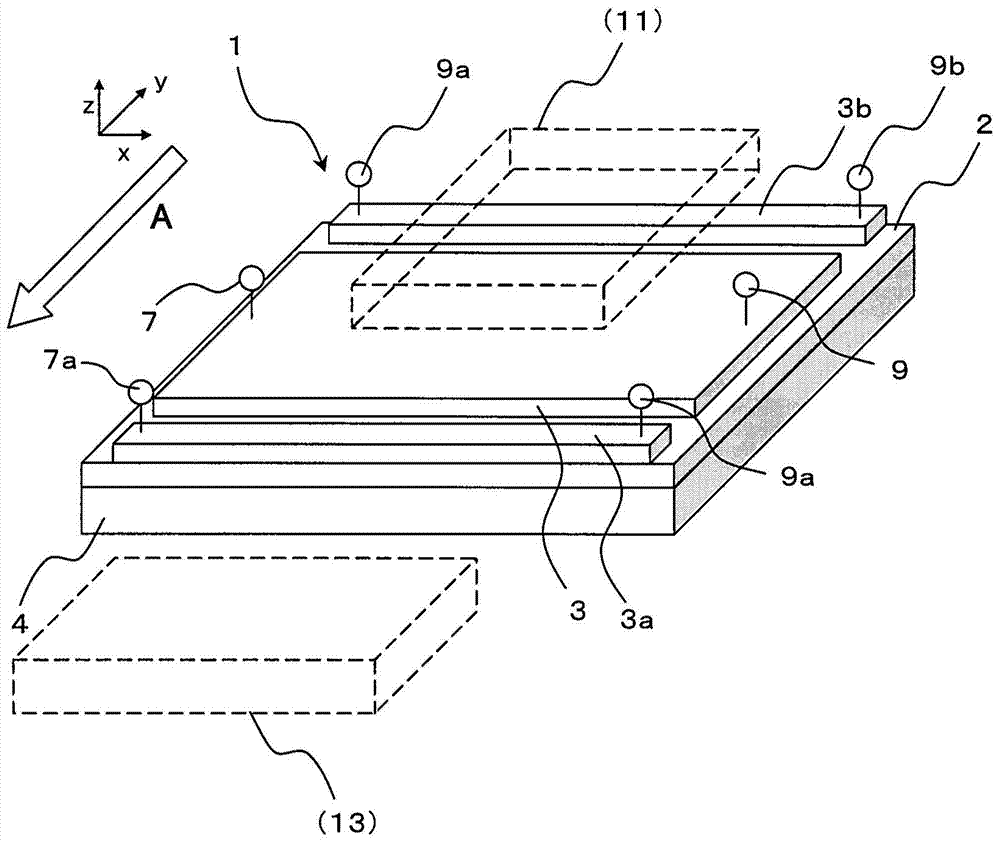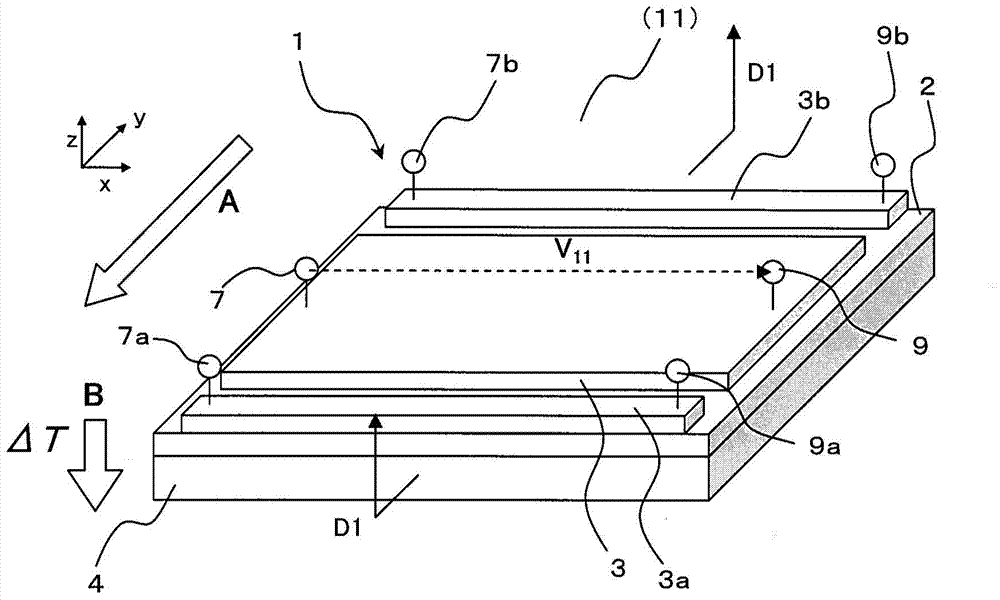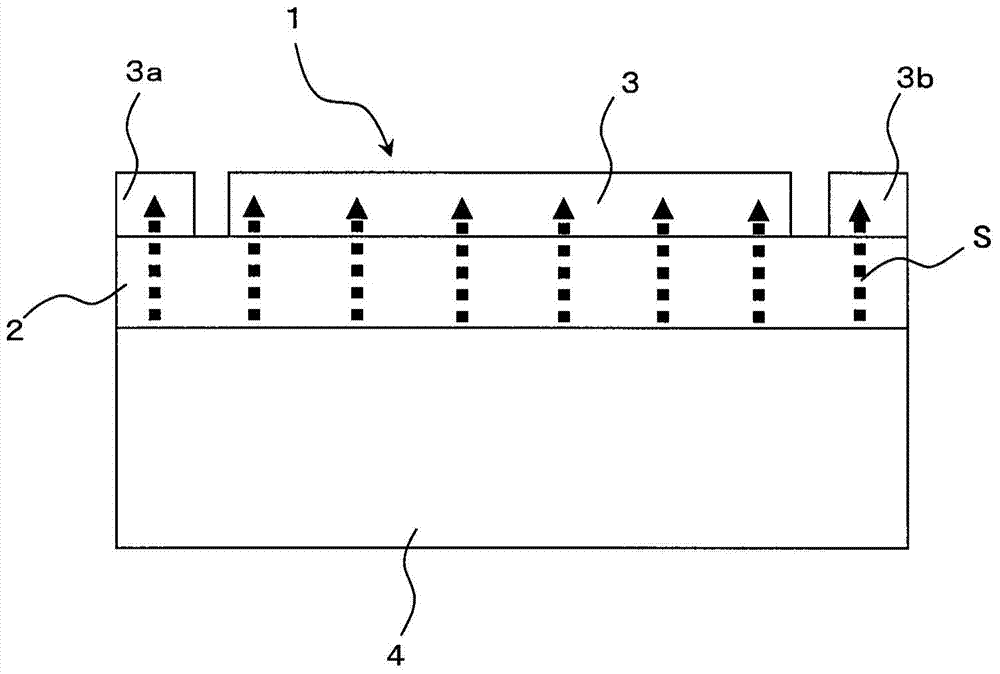Thermoelectric conversion element and thermoelectric conversion method
A technology of thermoelectric conversion and components, applied in the direction of electrical components, thermoelectric devices, circuits, etc., can solve problems such as inability to convert
- Summary
- Abstract
- Description
- Claims
- Application Information
AI Technical Summary
Problems solved by technology
Method used
Image
Examples
example 1
[0230] The thermoelectric conversion element 1 according to the first embodiment was manufactured. Specific steps are as follows:
[0231] First, as for the substrate 4, gallium-gadolinium-gallium garnet (hereinafter referred to as "GGG"; its composition is Gd 3 Ga 5 o 12 ) plane of the substrate (111). As for the magnetic film 2, an yttrium iron garnet film (the composition of which is BiY 2 Fe 5 o 12 ; hereinafter referred to as "Bi:YIG"). For the electrodes 3, 3a and 3b, Pt was used. In this case, the thickness of the GGG substrate was set to 0.7 mm, the thickness of the Bi:YIG film was set to 0.3 mm, and the thickness of the Pt electrode was set to 10 nm.
[0232] The Bi:YIG magnetic film 2 was formed by an aerosol deposition method. As for the raw material of Bi:YIG, Bi:YIG fine particles having a diameter of 300 nm were used. The Bi:YIG fine particles were stored in the aerosol generator container, and the GGG substrate was fixed to a holder provided in the fil...
example 2
[0235] A thermoelectric conversion element 1a according to the second embodiment was manufactured. Specific steps are as follows:
[0236] As the substrate 4a, a thermally conductive anisotropic substrate containing carbon fibers oriented in epoxy resin as a filler was used. The carbon fiber is oriented in a direction perpendicular to the plane with respect to the substrate, and has a large thermal conductivity in this direction.
[0237] As for the magnetic film 2, a yttrium iron garnet film (BiY 2 Fe 5 o 12 ). For the electrodes 3, 3a and 3b, Pt was used. In this case, the thickness of the substrate 4a was set to 0.3 mm, the thickness of the Bi:YIG film was set to 0.1 mm, and the thickness of the Pt electrode was set to 10 nm.
[0238] The Bi:YIG magnetic film 2 was formed by an aerosol deposition method. As for the raw material of Bi:YIG, Bi:YIG fine particles having a diameter of 300 nm were used. Bi:YIG fine particles were stored in the aerosol generator container...
example 3
[0241] A thermoelectric conversion element 1b according to the third embodiment was manufactured. Specific steps are as follows:
[0242] As for the substrate 4b having anisotropic heat conduction characteristics, a polyimide substrate having a thickness of 0.3 mm having a rear surface on which slits are formed, each having a thickness of 0.1 mm, is used. width and depth of 0.2mm.
[0243] As the magnetic film 2, a Bi:YIG film was used. For the electrodes 3, 3a and 3b, Pt was used. In this case, the thickness of the Bi:YIG film was set to 0.1 mm, and the thickness of the Pt electrode was set to 10 nm.
[0244] The Bi:YIG magnetic film 2 was formed by an aerosol deposition method. As for the raw material of Bi:YIG, Bi:YIG fine particles having a diameter of 300 nm were used. The Bi:YIG fine particles were stored in the aerosol generator container, and the substrate 4b was fixed to a holder provided in the film forming chamber. In this state, Bi:YIG fine particles are suck...
PUM
 Login to View More
Login to View More Abstract
Description
Claims
Application Information
 Login to View More
Login to View More - R&D
- Intellectual Property
- Life Sciences
- Materials
- Tech Scout
- Unparalleled Data Quality
- Higher Quality Content
- 60% Fewer Hallucinations
Browse by: Latest US Patents, China's latest patents, Technical Efficacy Thesaurus, Application Domain, Technology Topic, Popular Technical Reports.
© 2025 PatSnap. All rights reserved.Legal|Privacy policy|Modern Slavery Act Transparency Statement|Sitemap|About US| Contact US: help@patsnap.com



